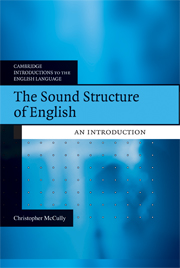Book contents
- Frontmatter
- Contents
- List of figures
- Acknowledgements
- A note on using this book
- 1 Introduction
- 2 Consonants (1): contrastiveness
- 3 Consonants (2): classification
- 4 Consonants (3): distribution
- 5 Syllables (1): introduction
- 6 Syllables (2): constituents
- 7 Syllables (3): structure
- 8 Vowels (1): short vowels
- 9 Vowels (2): long vowels and diphthongs
- 10 Vowels (3): variation
- 11 Problems, theories and representations
- Appendix: the IPA chart
- Glossary
- References
- Index of topics
- References
7 - Syllables (3): structure
Published online by Cambridge University Press: 05 June 2012
- Frontmatter
- Contents
- List of figures
- Acknowledgements
- A note on using this book
- 1 Introduction
- 2 Consonants (1): contrastiveness
- 3 Consonants (2): classification
- 4 Consonants (3): distribution
- 5 Syllables (1): introduction
- 6 Syllables (2): constituents
- 7 Syllables (3): structure
- 8 Vowels (1): short vowels
- 9 Vowels (2): long vowels and diphthongs
- 10 Vowels (3): variation
- 11 Problems, theories and representations
- Appendix: the IPA chart
- Glossary
- References
- Index of topics
- References
Summary
In this chapter …
In this chapter we develop our work on English syllables so as to say more about the structure of their internal constituents (the onset, nucleus and coda). Particularly important will be our work on the internal structure of the nucleus, since this will allow us to give a much more precise definition to our hunches about those phonological entities we've called long and short vowels (a short vowel is aligned with one and only one X-slot, while a long vowel is, like a diphthong, aligned with precisely two X-slots). We conclude the chapter by looking at the notions of light and heavy syllable, noting their complex relationship with stress as this is manifested within English words, and we also note issues that concern syllabification.
More on the structure of the onset
If we look first at onsets comprised of a single X, what kind of segment can that single X be? It can in fact be any consonant segment (including, possibly, /ø/), with the exception of …
What are the exceptions? They are /ʒ/ – which doesn't seem to occur as readily as a single-consonant onset as, say, /d/ or /m/ or indeed its voiceless equivalent, /∫/ – and /ŋ/.
- Type
- Chapter
- Information
- The Sound Structure of EnglishAn Introduction, pp. 91 - 106Publisher: Cambridge University PressPrint publication year: 2009

